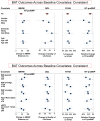Neuromodulation devices for heart failure
- PMID: 35991619
- PMCID: PMC9385122
- DOI: 10.1093/eurheartjsupp/suac036
Neuromodulation devices for heart failure
Abstract
Autonomic imbalance with a sympathetic dominance is acknowledged to be a critical determinant of the pathophysiology of chronic heart failure with reduced ejection fraction (HFrEF), regardless of the etiology. Consequently, therapeutic interventions directly targeting the cardiac autonomic nervous system, generally referred to as neuromodulation strategies, have gained increasing interest and have been intensively studied at both the pre-clinical level and the clinical level. This review will focus on device-based neuromodulation in the setting of HFrEF. It will first provide some general principles about electrical neuromodulation and discuss specifically the complex issue of dose-response with this therapeutic approach. The paper will thereafter summarize the rationale, the pre-clinical and the clinical data, as well as the future prospectives of the three most studied form of device-based neuromodulation in HFrEF. These include cervical vagal nerve stimulation (cVNS), baroreflex activation therapy (BAT), and spinal cord stimulation (SCS). BAT has been approved by the Food and Drug Administration for use in patients with HfrEF, while the other two approaches are still considered investigational; VNS is currently being investigated in a large phase III Study.
Keywords: Autonomic imbalance; Autonomic regulation therapy; Device-therapy; Neuromodulation; Sympathetic nervous system.
© The Author(s) 2022. Published by Oxford University Press on behalf of the European Society of Cardiology.
Conflict of interest statement
Conflict of interest: None declared.
Figures







Similar articles
-
NEUROMODULATION OF THE FAILING HEART: LOST IN TRANSLATION?JACC Basic Transl Sci. 2016 Apr;1(3):95-106. doi: 10.1016/j.jacbts.2016.03.004. JACC Basic Transl Sci. 2016. PMID: 27525317 Free PMC article.
-
Current and future use of neuromodulation in heart failure.Eur Heart J Suppl. 2022 Aug 17;24(Suppl E):E28-E34. doi: 10.1093/eurheartjsupp/suac031. eCollection 2022 Sep. Eur Heart J Suppl. 2022. PMID: 35991620 Free PMC article.
-
Updates on Baroreflex Activation Therapy and Vagus Nerve Stimulation for Treatment of Heart Failure With Reduced Ejection Fraction.Cardiol Res. 2022 Feb;13(1):11-17. doi: 10.14740/cr1330. Epub 2022 Jan 10. Cardiol Res. 2022. PMID: 35211219 Free PMC article. Review.
-
Vagal stimulation in heart failure.Herz. 2021 Dec;46(6):541-549. doi: 10.1007/s00059-021-05076-5. Epub 2021 Oct 30. Herz. 2021. PMID: 34716778 Free PMC article. Review.
-
Vagal nerve stimulation in myocardial ischemia/reperfusion injury: from bench to bedside.Bioelectron Med. 2024 Sep 13;10(1):22. doi: 10.1186/s42234-024-00153-6. Bioelectron Med. 2024. PMID: 39267134 Free PMC article. Review.
Cited by
-
The effect of transcutaneous auricular vagus nerve stimulation on cardiovascular function in subarachnoid hemorrhage patients: a safety study.medRxiv [Preprint]. 2024 Sep 8:2024.04.03.24304759. doi: 10.1101/2024.04.03.24304759. medRxiv. 2024. Update in: Elife. 2025 Jan 09;13:RP100088. doi: 10.7554/eLife.100088. PMID: 38633771 Free PMC article. Updated. Preprint.
-
Neuromodulation in heart failure.Eur Heart J Suppl. 2022 Aug 17;24(Suppl E):E1-E3. doi: 10.1093/eurheartjsupp/suac032. eCollection 2022 Sep. Eur Heart J Suppl. 2022. PMID: 35991622 Free PMC article. No abstract available.
-
Early experience with baroreflex activation therapy from a vascular surgery perspective.J Vasc Surg Cases Innov Tech. 2024 Feb 24;10(6):101464. doi: 10.1016/j.jvscit.2024.101464. eCollection 2024 Dec. J Vasc Surg Cases Innov Tech. 2024. PMID: 40027264 Free PMC article.
-
The Intrinsic Cardiac Nervous System: From Pathophysiology to Therapeutic Implications.Biology (Basel). 2024 Feb 7;13(2):105. doi: 10.3390/biology13020105. Biology (Basel). 2024. PMID: 38392323 Free PMC article. Review.
-
Comparison of the Effects of Left, Right, and Bilateral Carotid Baroreceptor Stimulation on Autonomic and Hemodynamic Responses Using an Indigenously Developed Paired Neck Chamber Device.Cureus. 2025 Apr 17;17(4):e82470. doi: 10.7759/cureus.82470. eCollection 2025 Apr. Cureus. 2025. PMID: 40385741 Free PMC article.
References
LinkOut - more resources
Full Text Sources
